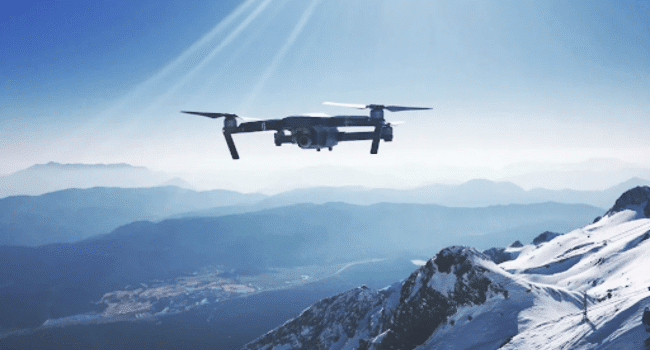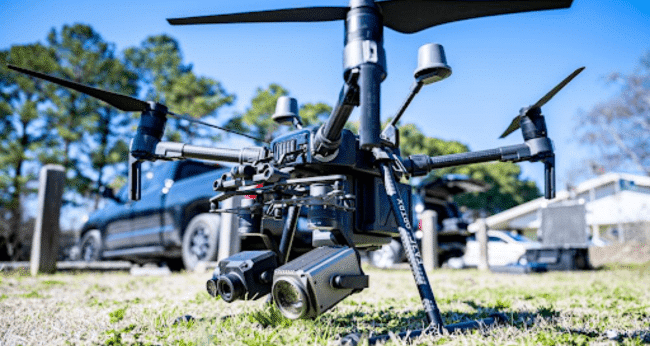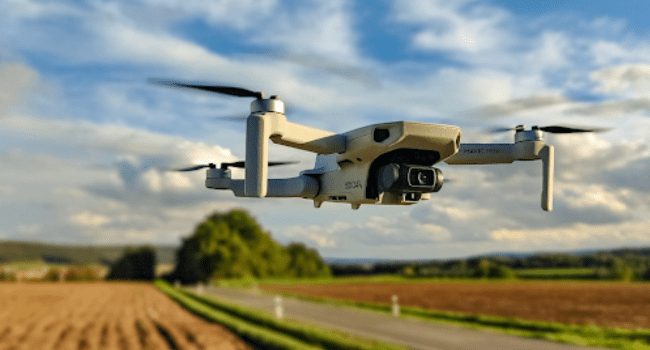Table of Contents
Over the past decade or so, the term “drone” has become commonplace. When you hear the word “drone,” you probably immediately think of a radio-controlled aircraft with rotors (rotor blades). It is no longer unusual to fly a drone and watch aerial images taken by its onboard camera.
Indeed, even the sky is no longer the limit, as advanced drones transform how we function, optimize processes, and unlock countless opportunities. Envision a world where drones fly above farms, precisely monitoring crop health and resource optimization or quickly delivering packages to your doorstep. Imagine them performing detailed aerial inspections of towering bridges or aiding firefighters during raging fires. These situations may seem like science fiction now but are quickly becoming an impressive reality.
The future of drones offers notable advances across numerous industries:
- In agriculture, drones will play a crucial role in enhancing efficiency while reducing environmental impact.
- Surveying and mapping will be elevated to new levels, as drones navigate challenging terrain with ease. Improved traffic congestion management could be just around the corner with these devices offering real-time updates from above.
- In emergency response situations, time is vital. Drones have the potential to significantly improve search and rescue efforts by accessing hard-to-reach areas faster than ever before.
- Disaster relief operations will also gain from these aerial marvels as they swiftly deliver essential supplies and gather critical information.
- The enchanting art of filming and photography will reach new heights with drones capturing extraordinary visuals and stunning panoramas from once-impossible angles.
- Additionally, environmental monitoring becomes more advanced as these flying machines help track weather patterns, monitor wildlife populations, and oversee delicate ecosystems.
Even space exploration is not out of reach for drone technology. Advanced drones may someday assist astronauts in conducting research or maintaining spacecraft during deep space missions. With such vast potential at our disposal, it’s no surprise that the global drone market is expected to surge to a staggering $48.1 billion by 2028. This tremendous growth results from advancements in technology that make drones safer, more efficient, and capable of performing intricate tasks with exceptional precision.
Trends in application of drones
In surveillance, drones provide heightened security with advanced features like Avitas Systems’ thermal imaging cameras and Skydio’s accurate flight controls. Furthermore, in military operations or search and rescue efforts, drones equipped with GPS navigation tools and night vision capabilities can save lives by rapidly locating individuals or identifying potential dangers. The DJI Matrice 300 RTK and Skydio 2 are setting new standards in aerial photography and autonomy, while Autel Robotics EVO II Dual offers thermal imaging capabilities with high-resolution video quality.

Various industries will benefit from drone technologies – including agriculture, airspace management, emergency response services, and security applications. Everyday package delivery systems will also be transformed as these machines become an integral part of our lives.
Since the early 2000s, drone technology has advanced significantly, playing crucial roles in space exploration missions, research, and surveillance. Compact, cost-effective, and agile drones like NASA’s NanoSats enable us to investigate star observations, radiation levels, and intriguing dust clouds. Once we may see drones servicing satellites in orbit or inspecting asteroids with remarkable accuracy.
The European Space Agency (ESA) is dedicated to developing autonomous drone technology for safe deployment in low orbits around Earth and beyond. In an exciting mission launched in 2019, four drones ventured into Venus’ upper atmosphere to collect valuable data on its composition. This impressive feat highlights the potential of drone advancements. Major companies like SpaceX are also aiming high by exploring innovative commercial applications such as satellite servicing, debris removal, and cargo delivery services to distant locations.
Drones are revolutionizing logistics and delivery, transforming the movement of goods, swiftly bypassing traffic and reaching remote locations with ease. This is one of the key strengths of drones: quicker, more efficient deliveries with an advanced touch. Leading companies like Amazon Prime Air, Google’s Project Wing, and UPS Flight Forward are driving this aerial transformation. Drones shall keep conquering their place in countries worldwide, which is confirmed by the efforts of Chinese e-commerce giants JD and Alibaba and Singapore Post’s collaboration with Flytrex.
As we discover new possibilities in drone technology, we come across cutting-edge devices like DJI Mavic Air 2, Parrot Anafi FPV, Autel Robotics EVO II Dual, Skydio 2 Autonomous Drone, and more. These pioneers push boundaries and inspire us to delve further into unexplored realms. These drones are not only unveiling innovative solutions but also showcasing how adopting this cutting-edge technology can lead to significant advancements across various industries.
Drones’ future
Future drone technology will bring even more remarkable applications, including enhanced package tracking, decreased transportation costs and emissions, and industry transformations. Drones will continue to not only simplify our lives but also enhance safety. Unmanned aerial vehicles can map hazardous areas like mines or nuclear power plants without endangering human lives. They can aid in delivering medical supplies to hard-to-reach places or support doctors in remote consultations, participate in search-and-rescue missions and help monitor crop fields, industrial facilities, etc.

The rapid growth of the drone industry will generate advancements in autonomous navigation, motion control systems, and sustainable energy. This progress will continue moving jobs toward the drone industry and improve safety in a crowded world. As drones become more integrated into various industries, ensuring proper coverage is essential. Learn more about drone insurance options at https://www.part107.com/drone-insurance.
Adopting drone-based logistics sets the stage for a future where swift delivery becomes standard. The latest drones available in the market are altering our perspective of the world. Their applications range from surveying and mapping to environmental evaluations and 3D modeling, significantly impacting numerous sectors.
Researchers are constantly working on groundbreaking technologies like robotic swarm intelligence and indoor mapping that bring us closer to a drone-filled world. As you consider all these possibilities – from AI-powered drones to augmented reality-enabled machines – fully embracing drone technology is a matter of time.
As drone technology evolves, we can anticipate increased autonomy, swarms communicating with each other, improved batteries for longer usage, and innovative designs inspired by nature. The potential applications are limitless – agriculture, construction, ocean exploration – and one thing is certain: this technology will continue to enhance our lives substantially.
For all those who have a drone of their own, but happen to need help regarding drone repair, the advice is simple – contact the professionals.
Read More on KulFiy
How Amazon Drone Delivery Can Change the Face of E-commerce?
